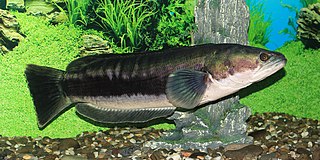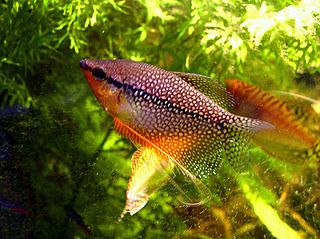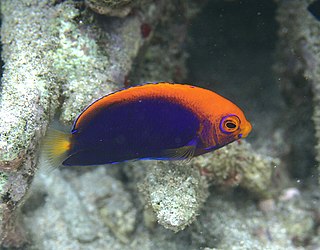
Channa is a genus of predatory fish in the family Channidae, commonly known as snakeheads, native to freshwater habitats in Asia. This genus contains about 50 scientifically described species. The genus has a wide natural distribution extending from Iraq in the west, to Indonesia and China in the east, and parts of Siberia in the Far East. A particularly high richness of species exists in Myanmar (Burma) and northeastern India, and many Channa species live nowhere else. In contrast, a few widespread species have been introduced to several regions outside their natural range, where they often become invasive. The large and medium-sized Channa species are among the most common staple food fish in several Asian countries, and they are extensively cultured. Apart from their importance as a food fish, snakeheads are consumed in some regions as a traditional medicine for wound healing and reducing postoperative pain and discomfort, and collected for the international aquarium pet trade.

Menticirrhus is a genus of marine ray-finned fish belonging to the family Sciaenidae, the drums or croakers. They are commonly known as kingcroakers or kingfish. These fish are found in the Western Atlantic and Eastern Pacific Oceans.

Channa bleheri is a species of dwarf snakehead that is endemic to the Brahmaputra River basin in the Indian states of Assam and Arunachal Pradesh. It is among the most colorful species of snakehead.

The pearl gourami is a species of gourami native to Southeast Asia.

Trichogaster is a genus of gouramis native to South Asia from Pakistan to Myanmar. It is the only genus in the monotypic subfamily Trichogastrinae as set out in the 5th Edition of Fishes of the World, although that book states that there are two genera, the other being Colisa which is treated as a synonym of Trichogaster by Fishbase and the Catalog of Fishes. Fishbase also places the genus in the Luciocephalinae. Species of this genus are very popular in the aquarium trade.

Dendrochirus biocellatus, the twospot turkeyfish, twinspot lionfish, twoeyed lionfish or ocellated lionfish, is a species of marine ray-finned fish belonging to the family Scorpaenidae, the scorpionfishes and lionfishes. This species is widespread throughout the tropical waters of the Indo-West Pacific region, In the wild, the species eats small fish as well as shrimp.

The orangeback angelfish, also known as the flameback angelfish, African pygmy angelfish and in South Africa as the Jumping Bean or Bean, is a species of ray-finned fish, a marine angelfish belonging to the family Pomacanthidae. It is found in the western Indian Ocean.

The treefish is a species of marine ray-finned fish belonging to the subfamily Sebastinae, the rockfishes, part of the family Scorpaenidae. It is native to the eastern Pacific Ocean.

The banded angelfish, also known as the bandit angelfish and three spine angelfish, is a distinctive species ray-finned fish belonging to the family Pomacanthidae. It is endemic to deeper reefs in Hawaii and the Johnston Atoll.

Genicanthus semifasciatus, the Japanese swallow, is a species of marine ray-finned fish, a marine angelfish, belonging to the family Pomacanthidae. It is found in the Western Pacific.
The blackspotted hawkfish is a species of marine ray-finned fish, a hawkfish belonging to the family Cirrhitidae. It is native to rocky shores of the western Indian Ocean. This species grows to 17 cm (6.7 in) in total length. This species is the only known member of its genus.

Chaetodontoplus mesoleucus, the vermiculated angelfish, is a species of marine ray-finned fish, a marine angelfish belonging to the family Pomacanthidae. It is found in the Indo-West Pacific region.

The spotbanded scat,(Selenotoca multifasciata), also known as the striped scat, banded scat, barred scat, butterfish, John Dory, Johnny Dory, old maid, Southern butter-fish or striped butterfish, is a species of ray-finned fish, belonging to the family Scatophagidae, the scats. They are found in the eastern Indian Ocean and southwestern Pacific Ocean.
Channa stewartii is a species of dwarf snakehead in the family Channidae, which is native to Nepal and the Indian states of Arunachal Pradesh, Assam, Manipur, Meghalaya, Nagaland and Tripura. It may also be found in Bangladesh. This freshwater fish mostly inhabits hill streams, but can also be found in ponds. It is of little value as a food fish but common in the aquarium trade.
Ophiogobius jenynsi is a species of ray-finned fish from the biology Gobiidae, the true gobies. It is a demersal, marine species which is found off the coast of Chile in the intertidal zone. It feeds mainly on crustaceans. This species was originally named as Gobius ophicephalus by Leonard Jenyns in 1842, subsequently misspelt as ophiocephalus, but this name was preoccupied by Pallas's 1811 Gobius ophiocephalus, Hoese renamed the species in honour of Jenyns in 1976. This is the only species in its genus.
Channa royi, the Andaman emerald snakehead, is a species of snakehead fish endemic to the Andaman and Nicobar Islands of India. This dwarf snakehead is distinct from other snakehead species due to its differing coloration, number of vertebrae, and teeth, most notably its greenish-gray dorsum. It was only scientifically described in 2018 and its closest relative is the Burmese snakehead, and a review in 2019 argued that the two are synonyms.
Trichopodus poptae is a species of ray-finned fish in the subfamily Luciocephalinae, part of the gourami family Osphronemidae. It is distinguished from its congeners by the faint, almost indiscernible patterning on the body apart from the black blotch at the base of the tail. This species is endemic to Kalimantan, the Indonesian part of the island of Borneo.

The licorice gourami is a species of freshwater ray-finned fish from the subfamily Macropodusinae, part of the family Osphronemidae, the gouramis. It is endemic to Bangka in Indonesia where it is found in the slow, flowing streams with black waters associated with peat swamp forests. This species was formally described by the Dutch ichthyologist Pieter Bleeker as Osphromenus deissneri in 1859 with the type locality given as Sungai Baturussa basin at 8 kilometres from Pudingbesar on the road to Kampong Simpan, Bangka. It is the type species of the genus Parosphromenus. The specific name honours F. H. Deissner, a military health officer, who sent a collection of specimens of fishes from Bangka to Bleeker which included the type of this species.

The halfbanded angelfish is a species of marine ray-finned fish, a marine angelfish belonging to the family Pomacanthidae. It is found in the southwestern Pacific Ocean.

Sebastolobus macrochir, the broadbanded thornyhead or broadfin thorny head, is a species of marine ray-finned fish belonging to the subfamily Sebastinae, the rockfishes, part of the family Scorpaenidae. It is found in deep waters of the northwestern Pacific Ocean.
















